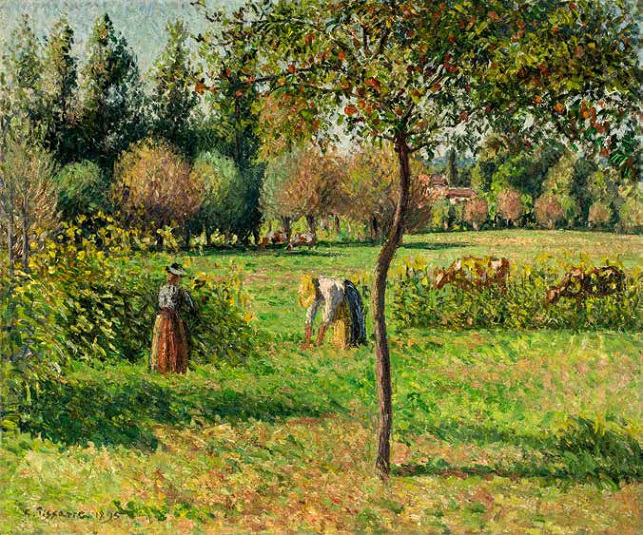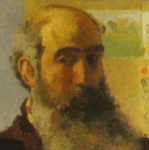
Camille Pissarro
French, 1830-1903
Meadow at Éragny, 1895
oil on canvas
21 x 25 1/2 in.
Private Collection

Camille Pissarro, Self Portrait, 1873
Camille Pissarro met Vincent van Gogh while the Dutchman was living in Paris in 1887 with his brother Theo. Pissarro is said to have predicted that Van Gogh would “either go mad or leave the Impressionists far behind”. A few years later he added: “That he would do both, I did not foresee.”
https://www.theartnewspaper.com/2021/02/19/pissarro-predicted-that-van-gogh-would-either-go-mad-or-leave-the-impressionists-far-behind
COMMENTS
“At what would be the final Impressionist exhibition in 1886, Georges Seurat declared the style passé with his monumental Sunday Afternoon on the Island of La Grande Jatte,” explains the text. “Perhaps the most radical innovation of the picture was the way in which Seurat translated the intuitive, comma-like brushstroke of Impressionism into a meticulously applied, regularized mark. Informed by scientific color theory, Seurat developed a system of notation that juxtaposed pure colors and would theoretically yield a greater luminosity than could otherwise be achieved, because the collocated strokes of color would fuse in the viewer’s eye, avoiding the ‘muddiness’ of palette mixing or blending colors on the canvas.”
“The anarchist and art critic Félix Fénéon championed the new style and christened it neo-impressionism, signaling a new, more scientifically rigorous and methodical form of impressionism. In Sunday Afternoon, a screen of colored dots partially masks a layer of varied brushstrokes beneath, but the overall effect is one of uniformity of mark-making that has come to be called pointillism. Seurat himself called it ‘chromo-luminarism’, and Paul Signac preferred the term divisionism, emphasizing the principle of divided color more than the application of paint.”
Pissarro tried this new style, partly because one of his children was keen on the technique. “Like Signac, Camille Pissarro and his son Lucien were drawn to the rigors of Seurat’s new manner, and both contributed neo-impressionist paintings to the 1886 exhibition. Camille Pissarro’s watercolor sketch of the Eragny Landscape demonstrates the principle of divided color and the pointillist brushstroke, though loosened up from the methodical dots that characterize many of Signac’s paintings; it can be seen to full effect in Seurat’s Les Poseuses (‘The Models’). The touches of pure color, often juxtaposed with their complement, produce an activated, pulsating surface.”
https://www.phaidon.com/agenda/art/articles/2017/july/10/a-movement-in-a-moment-pointillism/
SBMA CURATORIAL LABELS
Pissarro moved to the small village of Éragny in northern France in 1894 and would reside there, making paintings like this one, for the remainder of his life. Like Van Gogh, Pissarro experimented with Seurat’s and Signac’s pointillism, which he then adapted into a more versatile, less time-consuming technique of dashes and dots of pure color, as we see in this verdant meadow scene.
Pissarro was one of the most generous supporters of his fellow artists and had a direct impact on the evolution of the art of Paul Cézanne, Paul Gauguin, and most certainly, Van Gogh. It was Pissarro who suggested that Van Gogh seek the medical attention of Dr. Gachet in Auvers-sur-Oise, where Vincent went to stay after being treated at the asylum in Saint-Rémy.
- Through Vincent's Eyes, 2022
